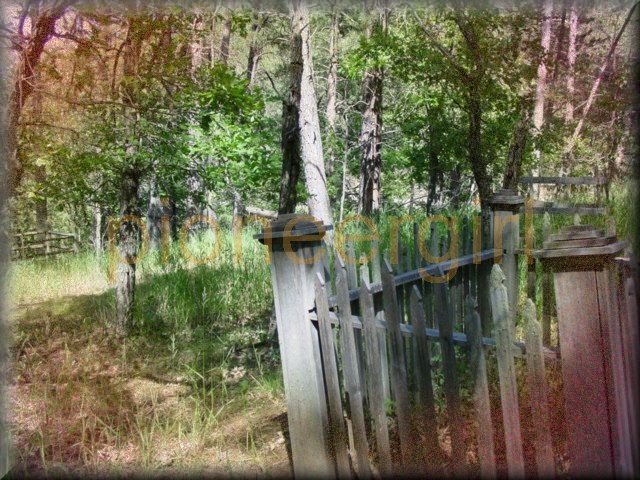Quiner graves

Abandoned cemetery near Keystone, South Dakota, where Polly and Henry Quiner and several children are buried.
 Dear Sister, Forgive us for not writing sooner. Your letter was the first to reach us and sad news it was. We had been talking a great deal and talking about dear Mother. Her death was not unexpected but it was hard to bear to think we never can see her again… That filled us with grief, believe me. Dear Sister I think that we can truly sympathize with you. We saw our own dear children fade and die, three of them in less than one short month. Oh it is hard to bear but we must be resigned and hope to meet them where parting is no more… – Polly Ingalls Quiner to Martha Quiner Carpenter, 27 November 1884, Harney City, Pennington County, Dakota Territory
Dear Sister, Forgive us for not writing sooner. Your letter was the first to reach us and sad news it was. We had been talking a great deal and talking about dear Mother. Her death was not unexpected but it was hard to bear to think we never can see her again… That filled us with grief, believe me. Dear Sister I think that we can truly sympathize with you. We saw our own dear children fade and die, three of them in less than one short month. Oh it is hard to bear but we must be resigned and hope to meet them where parting is no more… – Polly Ingalls Quiner to Martha Quiner Carpenter, 27 November 1884, Harney City, Pennington County, Dakota Territory
 AIn 2009, Wisconsin Historical Society finished scanning and putting their Carpenter-Quiner letters online HERE. The collection contains ninety-one pages from letters dating 1861 to 1910. A portion of a letter from Polly and Henry Quiner is transcribed above. (Please note that there were mistakes in the WHS listings of who wrote several of the letters, and when they were written; the archivists were made aware of corrections that need to be made and hopefully they have been updated.)
AIn 2009, Wisconsin Historical Society finished scanning and putting their Carpenter-Quiner letters online HERE. The collection contains ninety-one pages from letters dating 1861 to 1910. A portion of a letter from Polly and Henry Quiner is transcribed above. (Please note that there were mistakes in the WHS listings of who wrote several of the letters, and when they were written; the archivists were made aware of corrections that need to be made and hopefully they have been updated.)
Ruby, Charley, Lillian, and George Quiner, four of the seven children of Polly and Henry Quiner, died in the early 1880s and were buried in the now-abandoned cemetery outside of Keystone, South Dakota. Within a few years, both parents would join them. The graves were marked with a large family marker and smaller foot-stones with each person’s initials. Due to vandalism in the cemetery, the larger Quiner marker is now on display in the Schoolhouse Museum in Keystone; it’s shown at right. The smaller stones were left in place to mark the graves. The photograph below left shows Keystone historian Robert E. Hayes examining Ruby’s foot-stone in 2006. The photo above right shows fence post around other graves; the same post is marked in the photo with Hayes, shown to the west of Mr. Hayes. The bottom photos show Henry Quiner’s (H.O.Q.) and Ruby Qunier’s (R.A.Q.) foot-stones.
In 2009, a group of us who were in Keystone for Holy Terror Days went to the cemetery to again take photographs. While there are still a few headstones in the cemetery, we could not locate the Quiner stones. The flat, ground-level foundation for the larger Quiner marker was still there, so the stones that had previously stood a foot or more above ground should have been visible. The foot-stones were neither covered nor buried that we could determine. They were gone.
Hopefully they were just buried and we overlooked them, the sad reality is probably that someone took them. If you’ve been to the cemetery recently and were able to locate the Quiner stones, please let me know.

Directions to the cemetery. Take First Street [40] northeast out of Keystone a couple of miles to Playhouse Road; turn right across cattle gate onto Playhouse Road. A very short distance on Playhouse (1000 feet or so), you’ll turn right again across a cattle gate and be heading towards the water treatment plant. There will probably be cows roaming freely. The cemetery is a short walk up the hill into the Black Hills National Forest to your south, just past the turn off Playhouse. There should be one or two faint paths leading into the cemetery; look for the three weathered fenced-in family plots to find your way. If you walk directly towards the most ornate of the fenced areas (shown at right in the photo above), you will cross the Quiner graves prior to reaching the fence; look for the square, gray stone flat on the ground. The flat white stone on the ground does not mark the Quiner graves, but was where the main Quiner stone originally stood. If you are adventurous, you continue driving on Playhouse Road and go all the way to Custer State Park!

Quiner graves

